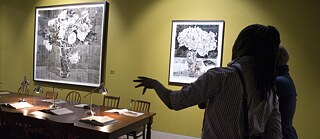Aesthetics and Advocacy Art Cannot Overthrow a Government, but…

To what extent can art change or shape political discourse in the society? South African artist and curator Molemo Moiloa sheds light on how artists in Africa have and continue to interrogate unfavourable power relations.
There is a myth that an artist creates from isolation of their studio and from some kind of internal drive and genius. This is rarely true. The arts are a deeply social practice and most artists make work as exploration of their current circumstances. Nevertheless, a veneer of aloof distance and abstract intellectualism remains a stereotype of the artist. This is partly due to the inheritance of a western modernist paradigm of art practice, too often without critique, merely to claim a place within the modernising global art scene. There have always been artists who sought a different strategy and they had their fair share of challenges.Thami Mnyele (1948 -1985), the South African artist and activist involved in the anti-apartheid struggles, the African National Congress and the Black Consciousness Movement, lamented in the 1980s that “The work of a socially committed artist is treated with traditional coldness. In this case, the large art of the critique dwells on how the artist is less of an artist and his work mere clichés. What is subtle in this piece of comment is the deliberate avoidance of the artwork: the actual meaning and intention of the work, its relation to the conditions that gave birth to it… the river of life. […] Never are we looked upon as conscious and committed men and women who carry the responsibility and the destiny of our country in our own hands”. (Mnyele, Thami: “Observations on the state of the contemporary visual arts” in South Africa, Kellner, Clive and Sergio-Albio Gonzalez (eds). Thami Mnyele + Medu Art Ensemble Retrospective, Johannesburg: Jacana, 2009)
This struggle is not new to many artists on the African continent, who have sought to explore some sense of an “authentic” artistic voice, but who have also felt drawn to use their creative talents against colonial, racist and apartheid regimes. For many, a social commitment limits the intrinsic artistic merit of the work, relegating it to ‘community work’ or ‘propaganda’. But for others, a social engagement is not only necessary, but inescapable.
Politicisation of Art
Things are changing, however, throughout the African art scene and there is a shift towards encouraging the social conscience and politicisation of artists and their work. This brings about its own concerns – of co-optation and bridling of political positions through their inclusion in the very structures that remain the problem. However, it does create more space and provide resources for artists to engage with pertinent issues and to work within their neighbourhoods and environments towards social change.“And in the contemporary moment you find artists responding to the historical colonial period and to the things that we learn about what happened during the colonial period. (…) And then they're also looking at a kind of neo-colonization that continues across the continent both by sort of European predecessors but also by others.”
Molemo Moiloa in the interview
Kaleni Kollective, for example, is based in Windhoek, Namibia. The collective is made up of creative practitioners who drive the Owela Festival, which brings together artists from across Southern Africa working in the intersection of arts and social justice. Or Inkanyiso, based in South Africa and established by Zanele Muholi, which is an educational platform for engaging LGBTQ+ narratives. Another example is Dzimbanhete, based just outside Harare, Zimbabwe, who are committed to the deepening of indigenous knowledge systems, linking the arts to healthcare, architecture, spirituality and landedness. There are of course, many more.
Aesthetics Opens up to Social Justice
For many of these artists, the relationship between artistic voice and social enagement is a complex one, and one that is likely always in flux. However, more space is increasingly becoming available for exploring these complexities and more openness to social justice taking its place within the aesthetic.“I think we've moved to a space now where there is an understanding that an artwork can have its intrinsic aesthetic value but also have something political and something important to say and respond to contemporary colonial issues.”
Molemo Moiloa in the interview
On how (post)colonial power relations affect artistic expression and on the role of the artists in dismantling (neo)colonialism and in safeguarding cultural heritage – an interview by the Goethe-Institut with Molemo Moiloa at the conference “Beyond Collecting: New Ethics for Museums in Transition” in Dar es Salaam, Tanzania, March 2020:
Play the interview as audio: